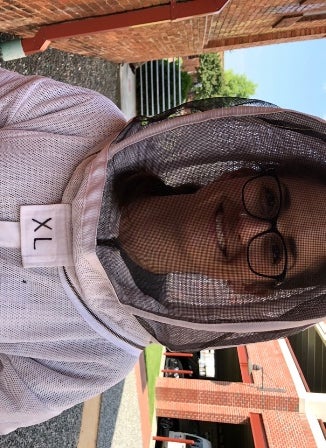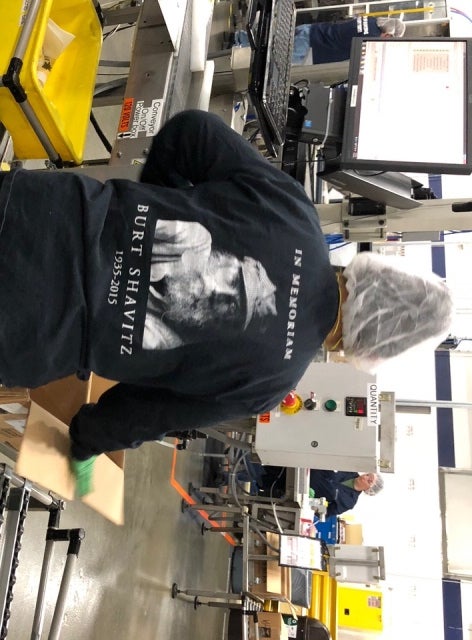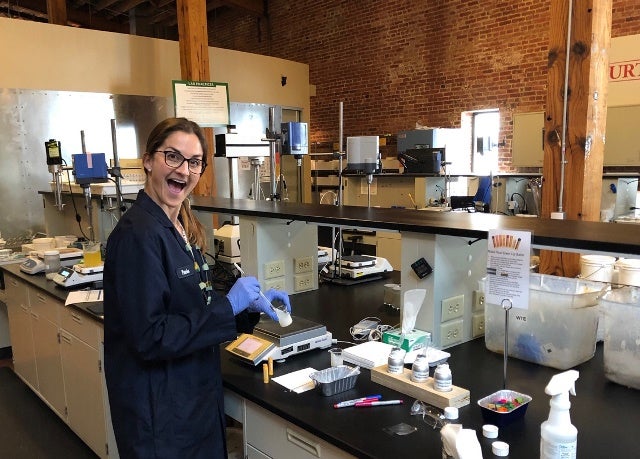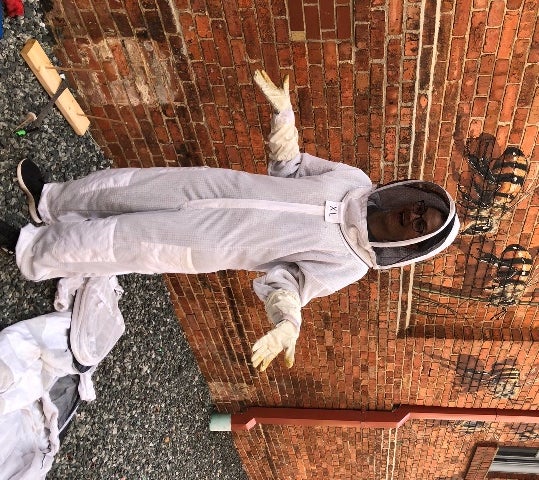Bay to Burt’s: A Clorox Eco Warrior’s Wanderings
By Leah Llach, group manager – eCommerce media sales
Eco Warriors is a dedicated, voluntary group of eco-passionate Clorox employees. One of them, Leah Llach, won the Clorox Eco Warriors Race to Zero Waste challenge — and a trip to Durham, North Carolina, to tour our Burt’s Bees facilities for inspiration. Her winning idea was “Reduce for Rewards,” a multi-stage, social media-based approach to make recycling at Clorox fun and competitive. Here, she shares her reflections and inspiration from two days at the Burt’s Bees manufacturing plant, office and R&D lab.

Leah Llach marks the Burt’s Bees hive’s queen bee.
The plant
I arrive in Durham after a sleepless redeye flight from San Francisco. After a quick latte and a change of clothes, I head to the Burt’s Bees plant.
There, I’m greeted by Chris Szymanski, Environmental Pillar Lead. He has me don a white lab coat (I feel instantly smarter), a hair net, ear plugs and a little something I like to call Clydesdale shoes. Clydesdales are enormous horses, and that’s exactly what you sound like when you prance around in these toe-saving-slippers. However, with safety a priority at Clorox, one must make fashion sacrifices in the interest of eco-adventuring. So here we go.
Chris leads me through the Burt’s Bees plant. The first thing I notice is that everything, and I mean everything, has a label and a taped outline of where it should fit or stand. And it smells like pine. Or lemon. Or maybe minty beeswax. There’s a lot going on, but everything is calm. People know what they’re doing and work with a sense of purpose.
It’s quickly clear to me that this is a complex network of decisions and impacts that I barely understand. The plant strives for zero waste, and I’m impressed by all the ways the plant is committed to this.
Still, I’m struck how even a zero-waste facility seems to generate some waste. When possible, imperfect products are taken out of rotation to be donated. And sometimes, when orders change mid-run, those products are donated, too, to minimize overall waste.
Even very sustainable plants where employees are passionate about minimizing waste leave a footprint, I learn. I can’t help but wonder what it’s like at other manufacturing plants that aren’t as committed to sustainability as Clorox-owned plants are.
I leave the plant with a handful of delightful Burt’s Bees ginger lime lip balms and loads of new information.

An employee works the line in the Burt’s Bees plant in North Carolina.
The office
Next, I head to the Burt’s Bees office, where I have lunch with Tracy Burton (sales planning business leader) and Lauren Newton (responsible sourcing analyst). We fall into easy conversation about things they’re excited about at the Burt’s campus and ways we can push sustainability even further as a company.
They introduce me to the Green Derby, a public review of the office’s trash. Green Derby leads actually sift through the bins and evaluate if everyone’s doing their part to sort waste correctly. Each floor gets a rating of green (yay!), yellow (meh) or red (Must. Do. Better.) It’s simple, motivating and everyone in the building is committed.
It feels like Burt’s Bees has mastered the art of making waste reduction fun, competitive and enforced from the ground up. People take responsibility for their trash, and if they’re not sure how to dispose of something, they know they can ask someone to help them figure it out. There’s a real ecosystem at work here, and it works. Green Derby results are prominently posted for inspiration and motivation.
A recycling station proudly displays Green Derby results at the BUrt’s Bees office in Durham, North Carolina.
The Lab
I meet my next host, Hector Nazario, a senior technician, and follow him into the “lab,” which is actually an open space integrated into the Burt’s Bees office. I love it. Hector shows me where they test products, scents, packaging, etc. He’s especially proud of how this team handles its trash. After all, everyone is part of the effort, even his group, with its plastic gloves and beakers. Some of these are readily recyclable, and some may require asking someone more knowledgeable how properly to dispose of them, which it’s totally in the Burt’s Bees culture to do.
The highlight was getting to make my own lip balm. I’m fascinated to learn that lip balm “flavors” are actually scent variations. Your brain does the work so the lip balm ‘tastes’ like the flavor. Mind = blown.

Leah Llach tries her hand at formulating lip balm flavors in a Burt’s Bees lab.
The Burt’s and Bees
I woke the next day thinking nothing would top the previous day. I was wrong. And I have two words for how wrong I was: Queen. Bee.
Ben Dictus, the Burt’s Bees beekeeper, explained what was happening in the office’s hive, which sits in the lobby of the building. Then he tells me our job for today: We’re going to take out the bee hive, clean the space a little and mark the queen bee with a green dot so people can see her. WOOHOOO!!
I put on a super spiffy beekeeper suit and am ready for action.
It was fun and fascinating to handle a beehive. With bees it is all about slow, deliberate movements and staying calm. These little ladies are hard-working and just want a safe place to live. Something about working with the littlest creatures makes you remember how much you impact the world around you.

Leah tried her hand at beekeeping at the Burt’s Bees headquarters.
The Lunch
It was on to my last Burt’s Bees lunch with Matt Kopac (manager – sustainable business & innovation, who just returned from the Ocean Leadership Sustainability Summit). What a delightful person with whom to discuss sustainability and food.
I shared that I was pumped by this whole trip to Burt’s Bees HQ but also overwhelmed. How can I care about everything and do anything useful? If I get a coffee I make waste. Does sustainability mean no more lattes? I like eating meat, but what’s the ethical choice? I thought fish was a more sustainable choice, but apparently large sea creatures are going hungry. Or are full of microplastic. Is meat really worse than tofu, which uses a lot of water to produce? And what about packaging?
All these thoughts feel like bees buzzing in my head, causing guilt and confusion. But it was calming to talk to Matt, who knows so much about sustainability issues.
The End. Or maybe the beginning.
Really, I’ve to come to terms with the fact no one person can do everything. But we can all do something. I left Burt’s Bees and Durham with a number of easy sustainability ideas for other Clorox offices. Here are a few:
- Provide nice cutlery and mugs for everyone. All we need is a dishwasher or someone to come through and collect and wash dishes. I’ve seen this done elsewhere, and it immediately cuts down on waste. It also encourages people to eat together, and that’s where ideas often come from: hanging out with other humans.
- Implement the Green Derby. We can do this, and it’s worth it.
- Continue to set the example on packaging and products with our entire portfolio. Consumers like me are looking for big brands to care with us.
In terms of my personal goals, here are my three biggest:
- Buy groceries as I need them and go to the store myself. This will help me avoid ordering in bulk and throwing away foods that spoil because I can’t eat them fast enough and they don’t fit in my freezer. Plus, I can control more around packaging waste.
- Eat less meat. I’m experimenting with meatless meals that also have enough protein to fuel my runs (I average 30 or so miles every week.) I’m not ready to go veggie, but since little things make a big difference, I’m all-in on making change.
- I’m buying another flowering plant so that I can maybe give bees some food. Plus, flowers are lovely.




